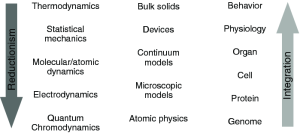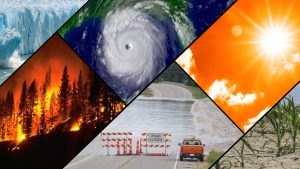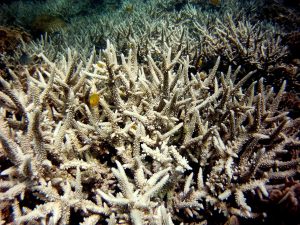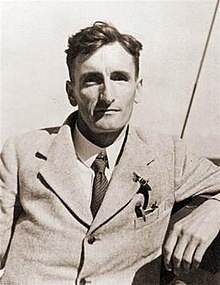6 Reduction
dbyenice
Introduction
When you look up the etymology for the word ‘reduction‘, you will find that the word finds its origin in the Latin word ‘reducere‘, which means ‘to bring back‘ or ‘restore‘.[1] If we look liberally at what we essentially do when asserting that x can be reduced to y, we essentially restore x to y (Figure 1).

It is this search for the most fundamental concept or substance that has made its way into the sciences. This is why people call this kind of reduction scientific reductionism or methodological reductionism. These two terms are used interchangeably, but I will refer to the concept as scientific reductionism. This is also the kind of reduction many people think of when faced with the concept.
Additionally, especially in regards to the topic of climate change, there is another kind of reduction that is interesting, which is theory reductionism. In the next section, I will explain what both types of reductionism entail exactly and show how different, yet equally interesting, both philosophical tools are.
Finally, there is still a lot of misinformation surrounding the topic of climate change. I made a short video poking fun at this. You can watch that video using the link in the chapter if you like.
scientific reductionism
Scientific reductionism aims to look for the fundamental explanations of a certain phenomenon or concept. Many things in the world have specific underlying causes or can be explained by means of these underlying causes. An example is one of the questions that was asked in the 20th century: can classical genetics be reduced to molecular biology?[2] Biology is a famous starting point in this context, as many biological concepts can be reduced to what is referred to as more fundamental sciences. In this sense, there is a hierarchy of levels at which the sciences, and scientific concepts, operate (Figure 2).

Source: researchgate.net
But what exactly does this hierarchy entail? In the philosophy of biology, it is often discussed how biology relates to two sciences that are considered to be more fundamental: chemistry and physics.[3] The process of life can be reduced to continuous chemical reactions happening in the body, keeping it alive. However, these chemical reactions can in turn be reduced to the collision of atoms and molecules, which brings us to the level of physics. Therefore, biology as a science can be reduced to the fundamental science of physics.
Scientific reduction looks at specific (scientific) concepts as well. Biology serves as a good example for this again. If we truly wish to understand how an organism functions, we have to break it down into smaller pieces so that we can study each individual concept of that organism. It is here where the famous ‘breaking down a whole into the sum of its parts’ idea behind reductionism is realized. Furthermore, the hierarchy of levels still applies here, as biological concepts can still be reduced to chemistry or physics. This kind of reductionism is not only applicable in the sciences, but also within the world of philosophy (Examples 1). It should however be noted that there is still value in looking at the concept itself, without applying the reduction. Even though biology can be reduced to physics, the level of science at which biology operates is able to explain things that physics simply cannot. Physics cannot explain how certain enzymes work, but the biological level of science can. Reduction should help us understand a concept better at a fundamental level. It should not replace a science or a level of science entirely.
Examples 1
- What does the ethical consist of? Do ethical concepts really exist, or are they human constructs?
- What is knowledge? Is it a justified true belief, or does it consist of more parts?
- What is a state? Is it the accumulation of a people on a piece of land with a government, or does legitimization play an important role as well?
- When can we say that something has a mind? Do we only judge by behavior, or do we need to look at functional roles that certain parts may play? What do these parts need to do in order to qualify as realizing a mind?
Theory reductionism
Theory reductionism is a rather interesting kind of reduction, but the use of the term may be a bit misleading. Theory reductionism entails the evolution or development of a certain theory. The word ‘reduction’ is misleading in the sense that, at least in my opinion, it implies moving back to the basics, when in reality the original theory is reduced to the newer, often more general theory.[4]

It is however debatable how similar the reducing and the reduced theories have to be in order to consider one replacing the other. It is here where various different interpretations on theory reduction exist. In this chapter, I will assume the Nagelian model of reduction as explained by Ernest Nagel. This section will serve to explain the Nagelian model as he described it in his book The Structure of Science.
What is important to theory reduction in the Nagelian sense is that older, more specialized theories get a so called fresh use in the new, reduced theory.[5] This is how theory reduction separates itself from progress within a theory itself: older theories get applied to new situations when reduction takes place, whereas scientific progress strictly remains within the set framework. Here the generalization of theory reduction plays an important role, as it is this generalization that separates the concept from scientific progress. Nagel distinguishes two types of reduction: the homogeneous reduction and the heterogeneous reduction.[6]
The homogeneous reduction is what Nagel describes as the least controversial type. It entails what I described earlier: a specific theory or law meant for one theory gets absorbed into a more general theory. The most famous example of this is Kepler’s laws of motion of the planets and Galileo’s laws of motion. These more specialized theories have been completely reduced to Newton’s laws of motion, as the latter theory has absorbed the former two, making Newton’s laws more fundamental.[7] Elements of the specific former theories have been absorbed into the more general theory because they fit into what the newer theory wants to accomplish. Galileo’s laws of motion were originally meant to describe free-falling, terrestrial motions, yet Newton applied it to both terrestrial and celestial motions, which makes the theory more general.[8] Additionally, when Newton absorbed Galileo’s theory into his own, there were no issues regarding ‘translation’: both were talking about the same kinds of motion. The only difference is the context in which the theory is applied. Therefore, because the two theories were easily absorbed into Newton’s theory, without the need for translation, this type of reduction is homogeneous. It is important to note that homogeneous reduction is often what comes to mind when talking about the normal progress of a science, since no leaps are made between different disciplines and sciences.[9] We focus on a specific discipline, which in turn results in scientific progress within that discipline.
The heterogeneous reduction is more controversial, as it is here where translation becomes necessary. This is so because elements of one science, the secondary science, are used to describe completely different concepts and phenomena of another science, the primary science, resulting in cases where the elements of the secondary science were never meant to describe cases for the primary science, yet are still used to reduce the theory of the primary science. Nagel draws on the example of temperature. Someone who understands temperature as a reading on a thermometer will have a hard time understanding what temperature means in the context of the kinetic theory of gases. Both mention the context of temperature, yet they mean completely different things.[10]
This disconnect between the primary and secondary sciences is common in heterogeneous reductions. The concept that is reduced may not mean the same thing at all when it is reduced. However, there is still a larger line that connects the concept to each level of the reduction. Even though some elements of the secondary science are lost in the reduction, it does not make the reduction any less valid or true.
Now that the most important concepts have been explained, namely the scientific reduction and theory reduction, we can finally apply it to the concept of climate change. In the next section, I will first apply the scientific reduction, followed by the the theory reduction. I will demonstrate why the scientific reduction is valuable when applied to climate change, and why the theory reduction, as explained by Nagel, does not work on this tool.
Exercise
Exercise 1:
- Try to come up with an example of a scientific or theoretical reduction yourself. For the scientific reduction, look for an object or being around you and break it down into its smaller parts. For the theory reduction, look for a famous scientific theory, such as the theory of relativity, and look for the theories that came before it.
Exercise 2:
- How would you reduce yourself? What is fundamental about you? How would you break yourself down into smaller parts?
Scientific reductionism and climate change: what is the cause?
If we are to apply scientific reductionism to the concept of climate change itself, then we have to look at the more fundamental concepts that climate change is made up of. So, what exactly is climate change then? We should start by looking for a proper definition of the concept. This will allow us to properly break it down into its more fundamental parts.
If we look at the website of the United Nations, we find that climate change is a shift in temperature and weather patterns. This change in temperature and weather is long-term.[11] This definition is neutral in regards to the influence of humans on the climate. Since this handbook deals with modern climate change, where it has been proven that human emissions play a large role concerning climate change, I will focus on modern climate change when performing my reduction.
Now, the definition of climate change that I will reduce is as follows: the concept of modern climate change is a long-term shift in temperature and weather patterns caused by human emissions. If we want to look at the root cause of climate change, we have to zoom in on the human emissions part. In a sense, this is already a reduced version of the concept of climate change: we looked for underlying and fundamental causes of climate change. In the modern context, the main influence is human emissions.
However, saying that modern climate change is mainly caused by human emissions does not fully break down the driving cause for climate change. What are these emissions? Not all human emissions cause climate change, so there must be a specific subset of emissions that we can focus on. We can reduce the concept even further by looking more closely at the human emissions part. How are we causing these emissions? According to the science, we are doing so by burning fossil fuels. We are now at an even more fundamental level, yet we can go even further.
What exactly is emitted when burning fossil fuels? Greenhouse gases. Yet simply emitting greenhouse gases does not fully encapsulate what exactly drives climate change. How do these gases drive climate change? According to NASA, these greenhouse gases are heat-trapping.[12] Normally, some of the heat from the sun that reaches the earth is reflected back into space by the Earth, yet these greenhouse gases trap this heat, causing the Earth to heat up (Figure 4). In this sense, the cause of climate change can be reduced to the planet suffering from a more severe energy imbalance than usual.

Source: education.cfr.org
But why do these gases remain in the atmosphere? The underlying cause of that is the cutting of trees and forests. When we break down the cause of human-driven climate change, all these concepts come to light. This is of great value when it comes to matters of finding a solution. You can see that this is already true in practice. We focus on finding alternative sources of energy that are clean and there are many reforestation efforts all around the globe. By knowing the source of the problem, we can find solutions.
When considering our original definition of climate change, these underlying, fundamental causes may go unnoticed. By performing a scientific reduction and breaking down concepts, we start to see these smaller driving forces behind climate change. Now we have reduced the cause of climate change, but that is only half of the issue. What does the concept of climate change itself mean?
Scientific reductionism and climate change: what does it mean?
The term ‘climate change’ refers to a great many things. Because it is such a big concept, we can lose sight of the actual problems we are facing. Therefore, there is epistemic value in breaking down the concept of climate change into its individual parts. In the previous section, we already reduced it to the source of the problem. Now, we will try to find what climate change itself actually means. I will sum up a few elements of climate change here. I will not be able to cover them all, but I hope to demonstrate how the concept of reduction can be applied here.

Source: National Oceanic and Atmospheric Administration (NOAA.gov)
The first thing that may come to mind when thinking about what climate change is is global warming. In fact, these terms are often used interchangeably, even though they refer to very different things. Global warming is the phenomenon of the planet heating up, while climate change refers to the consequences of the planet heating up. In any case, global warming is a fundamental part of climate change.
Another concept that makes up a fundamental piece of climate change is more extreme weather. As has been noted by NASA, heat waves, heavy rainfall, floods, droughts, wildfires and hurricanes have become more frequent and severe as a result of climate change.[13] These phenomena all are part of climate change, yet may get lost if we only look at the issue holistically.
Another part of climate change concerns the changing ecosystems. Ecosystems around the world have adapted to specific weather patterns and temperatures. Due to climate change, some ecosystems have fallen out of balance. Think of the destruction of great coral reefs because the water is becoming too warm. The changing of ecosystems is an important part of climate change as a whole.

As a final example, rising sea levels make up an important part of what climate change entails too. This is especially relevant for people who live in areas near water. As was mentioned earlier, floodings have become more regular due to the effects of climate change. By performing a scientific reduction, we can clearly identify this issue and act accordingly. In the Netherlands, we have increased the sizes of our dikes in order to counter the rising sea levels. This is an act that is meant to fight against one specific element of climate change. Even though it may only be one element, this act of preparation may save countless lives down the line.
In short, what I have tried to do in this section is give a clearer meaning of what climate change actually is. Climate change is the phenomenon consisting of global warming, more extreme weather, the dying and changing of ecosystems and rising sea levels. There is of course a lot more that could be added to this reduction as I said earlier, but I hope that I have gotten my point across: climate change is a holistic conception of the issue that is made up of many different elements. Furthermore, there is value in identifying these individual elements in order to find a solution to the issue.
As I mentioned in this section, there are many more parts to the meaning of climate change than the ones I covered here. Climate change is a multi-layered, cross-disciplinary issue, which makes the scientific reduction so interesting, as new insights into climate change may be revealed. In the exercises below, you will explore what other components contribute to the issue of climate change and apply the scientific reduction in a different context!
Exercise
Exercise 3:
- Try to think of other elements that climate change is made up of. Add onto the mentioned reduction of climate change.
Exercise 4:
- Look for an object in your vicinity. Reduce it into its smaller, fundamental parts. Have you come to any new insights about the reduced object?
Applying theory reduction to climate change: why it fails
As we have seen in the previous section, the issue of climate change can be scientifically reduced to many individual parts, including global warming, changing ecosystems and more extreme weather. You would think that, because these issues are more specialized and fundamental, this would translate into climate change being theoretically reducible. This, however, is not so evident. As I described, a theoretical reduction entails that specialized scientific theories get a fresh use or a different context. In the case of climate change however, there does not seem to be such an original, specialized theory that got applied to a broader context. Historical evidence suggests instead that the theory itself simply improved over time. This is an important difference. In order to better understand theoretical reduction, I will explain why it is not applicable to the theory of climate change.
According to UK Research and Innovation, the history of climate change discoveries goes back to 1938, when Guy Stewart Callendar discovered that global temperatures were rising.[14]

Source: Wikipedia.org
Callendar believed that the emission of carbon dioxide was the main driving force behind the rising temperatures. Even though his model was accurate for its time, and even though we now know he was right, the scientific community ignored Callendar. However, the seed for our modern understanding of climate change had been planted.
Many years later, in 1958, Dr Charles David Keeling was the first man to measure that atmospheric carbon dioxide levels were rising.[15] This data would become important when we discovered the atmospheric carbon dioxide levels of years prior. This was done in 1985 when scientists started to drill in Antarctica, discovering gas bubbles in the ice, which turned out to be a reliable indicator of the composition of the Earth’s atmosphere at the time. This discovery showed a clear relation between the concentration of greenhouse gases in the atmosphere and temperatures on Antarctica.[16]
It was also around this time, namely in 1985 as well, when the hole in the ozone layer was discovered. Many people believe it was this event that caused the global community to take climate change seriously. Further events, such as the realization that coral reefs were under threat, were all discovered to be related to climate change. The concept started to broaden. Where in 1988 the terms global warming and climate change were used interchangeably, climate change became the favored term in the early 2000s.
Even though our understanding of climate change has broadened over the years, making it more general, since it covers many issues, this is not an example of theory reduction, for we simply add onto a theory instead of generalizing established theories within a new context. This example is supposed to make it clear that there is a difference between the evolution of a scientific theory, namely the example of Newton, and evolution within a science, which is climate science. Therefore, climate change is not an example of theory reduction.
Conclusion
A scientific reduction can be of incredible epistemic value when applied to climate change. First, it allows scientists to find the core causes of climate change, which will aid us in the search for effective solutions to the issue. By looking at the foundation of the problem, we can apply targeted measures. Furthermore, a scientific reduction can help us to see what the climate issue is truly all about. The epistemic value here lies in the prevention or anticipation of disasters, as well as in convincing potential doubters that these issues are indeed attributable to climate change. More extreme weather is a part of climate change and not something that simply occurs on its own. Droughts are attributable to it too and global warming is a core part of climate change. By reducing the holistic concept to its parts, we get a clearer view of what we are dealing with.
Unfortunately, climate change is not a candidate for the theoretic reduction, but I hope that by means of a counter-example, the idea of what a theory reduction entails has become clear.
bibliography
- van Riel, Raphael and Robert Van Gulick, “Scientific Reduction”, The Stanford Encyclopedia of Philosophy (Spring 2024 Edition), Edward N. Zalta & Uri Nodelman (eds.), URL = <https://plato.stanford.edu/archives/spr2024/entries/scientific-reduction/>.
- Brigandt, Ingo and Alan Love, “Reductionism in Biology”, The Stanford Encyclopedia of Philosophy (Summer 2023 Edition), Edward N. Zalta & Uri Nodelman (eds.), URL = <https://plato.stanford.edu/archives/sum2023/entries/reduction-biology/>.
- Palacios, Patricia, “Intertheory Relations in Physics”, The Stanford Encyclopedia of Philosophy (Spring 2024 Edition), Edward N. Zalta & Uri Nodelman (eds.), URL = <https://plato.stanford.edu/archives/spr2024/entries/physics-interrelate/>.
- Nagel, E. (1961). The Reduction of Theories. In E. Nagel, the Structure of Science (pp. 336-397). New York, Chicago, San Francisco, Atlanta: Harcourt, Brace & World.
- What Is Climate Change? (n.d.). Retrieved from UN.org: https://www.un.org/en/climatechange/what-is-climate-change#:~:text=Climate%20change%20refers%20to%20long,activity%20or%20large%20volcanic%20eruptions.
- Extreme weather and climate change. (n.d.). Retrieved from NASA.gov: https://science.nasa.gov/climate-change/extreme-weather/
- A brief history of climate change discoveries. (n.d.). Retrieved from UKRI: https://www.discover.ukri.org/a-brief-history-of-climate-change-discoveries/index.html
note on images
Figure 1: https://en.wikipedia.org/wiki/Reductionism
Figure 2: https://www.researchgate.net/figure/Reductionism-and-post-reductionist-integration-in-physics-materials-science-and-biology_fig6_6841781
Figure 3: Created with Canva
Figure 4: https://education.cfr.org/learn/reading/greenhouse-effect
Figure 5: https://www.noaa.gov/education/resource-collections/climate/climate-change-impacts
Figure 6: Eco Cafe’ Pranburi via Flickr (CC BY-SA 2.0)
Figure 7: https://en.wikipedia.org/wiki/Guy_Stewart_Callendar
hyperlinks
- https://www.britannica.com/biography/Ernest-Nagel
- https://www.youtube.com/watch?v=Dvoe8Ib5D1o
- https://www.youtube.com/watch?v=vzYhw7mWQJ8
- https://www.youtube.com/watch?v=-w6oW1ut4Dw
- https://www.un.org/en/climatechange/what-is-climate-change#:~:text=Climate%20change%20refers%20to%20long,activity%20or%20large%20volcanic%20eruptions.
- https://science.nasa.gov/climate-change/what-is-climate-change/
- van Riel, Raphael and Robert Van Gulick, "Scientific Reduction", The Stanford Encyclopedia of Philosophy (Spring 2024 Edition), Edward N. Zalta & Uri Nodelman (eds.), URL = <https://plato.stanford.edu/archives/spr2024/entries/scientific-reduction/>. ↵
- Brigandt, Ingo and Alan Love, "Reductionism in Biology", The Stanford Encyclopedia of Philosophy (Summer 2023 Edition), Edward N. Zalta & Uri Nodelman (eds.), URL = <https://plato.stanford.edu/archives/sum2023/entries/reduction-biology/>. ↵
- Brigandt, Ingo and Alan Love, "Reductionism in Biology", The Stanford Encyclopedia of Philosophy (Summer 2023 Edition), Edward N. Zalta & Uri Nodelman (eds.), URL = <https://plato.stanford.edu/archives/sum2023/entries/reduction-biology/>. ↵
- van Riel, Raphael and Robert Van Gulick, "Scientific Reduction", The Stanford Encyclopedia of Philosophy (Spring 2024 Edition), Edward N. Zalta & Uri Nodelman (eds.), URL = <https://plato.stanford.edu/archives/spr2024/entries/scientific-reduction/>. ↵
- Nagel, E. (1961). The Reduction of Theories. In E. Nagel, the Structure of Science (pp. 336-397). New York, Chicago, San Francisco, Atlanta: Harcourt, Brace & World pag. 337-338 ↵
- Nagel, E. (1961). The Reduction of Theories. In E. Nagel, the Structure of Science (pp. 336-397). New York, Chicago, San Francisco, Atlanta: Harcourt, Brace & World, pag. 338 - 345 ↵
- The use of the words 'law' and 'theory' in this paragraph are interchangeable: Kepler's and Galileo's laws of motion can be considered as theories of motion. ↵
- Nagel, E. (1961). The Reduction of Theories. In E. Nagel, the Structure of Science (pp. 336-397). New York, Chicago, San Francisco, Atlanta: Harcourt, Brace & World pag. 339 ↵
- Nagel, E. (1961). The Reduction of Theories. In E. Nagel, the Structure of Science (pp. 336-397). New York, Chicago, San Francisco, Atlanta: Harcourt, Brace & World pag. 339 ↵
- Nagel, E. (1961). The Reduction of Theories. In E. Nagel, the Structure of Science (pp. 336-397). New York, Chicago, San Francisco, Atlanta: Harcourt, Brace & World pag. 339-342 ↵
- What Is Climate Change? (n.d.). Retrieved from UN.org: https://www.un.org/en/climatechange/what-is-climate-change#:~:text=Climate%20change%20refers%20to%20long,activity%20or%20large%20volcanic%20eruptions. ↵
- https://science.nasa.gov/climate-change/what-is-climate-change/ ↵
- Extreme weather and climate change. (n.d.). Retrieved from NASA.gov: https://science.nasa.gov/climate-change/extreme-weather/ ↵
- A brief history of climate change discoveries. (n.d.). Retrieved from UKRI: https://www.discover.ukri.org/a-brief-history-of-climate-change-discoveries/index.html ↵
- A brief history of climate change discoveries. (n.d.). Retrieved from UKRI: https://www.discover.ukri.org/a-brief-history-of-climate-change-discoveries/index.html ↵
- A brief history of climate change discoveries. (n.d.). Retrieved from UKRI: https://www.discover.ukri.org/a-brief-history-of-climate-change-discoveries/index.html ↵
